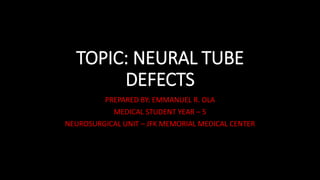
NEURAL TUBE DEFECTs.pptx
- 1. TOPIC: NEURAL TUBE DEFECTS PREPARED BY: EMMANUEL R. OLA MEDICAL STUDENT YEAR – 5 NEUROSURGICAL UNIT – JFK MEMORIAL MEDICAL CENTER
- 3. DEFINITION •A neural tube defect, also known as spinal dysraphism, is a congenital condition where the covering of the central nervous system does not fully develop due to a failure of the neural tube to close during the 3rd or 4th week of embryonic development.
- 4. EPIDEMIOLOGY • 1 in 1,500 births in the United States • 2nd-most common major congenital anomalies (most common are cardiac anomalies) • Incidence • Has decreased with prenatal folic acid supplementation and screening • Varies by ethnicity and geographic region • Female neonates are affected more commonly.
- 5. EPIDEMIOLOGY • Maternal risk factors during pregnancy: • Folate deficiency • History of NTD in previous children (5%–10% recurrence with 1–2 affected siblings) • Folic acid-depleting medications (valproic acid, triamterene, trimethoprim, sulfasalazine) • Poorly controlled maternal diabetes • Maternal obesity
- 6. CLASSIFICATION • Open NTD (80% of cases): a midline defect of the vertebral bodies with different degrees of protrusion of the meninges and central nervous system (CNS) • Defect along the spinal cord: •Meningocele: Only the meninges protrude. •Meningomyelocele: Both meninges and spinal cord protrude (most common NTD).
- 7. CLASSIFICATION Defect of the cranium: •Cranial meningocele: Meninges protrude. •Cranial encephalocele: Both the meninges and brainstem/cerebellum/cerebral cortex protrude. •Anencephaly: complete failure of the cephalic neural tube to close resulting in a fully exposed fetal brain (not compatible with life)
- 8. CLASSIFICATION • Closed NTD: a midline defect of the vertebral bodies without protrusion of the meninges or neural tissue • Without subcutaneous mass: spina bifida occulta • With subcutaneous mass: •Lipomyelomeningocele •Lipomeningocele
- 9. EMBRYOLOGY • Conception to 3rd week of gestation (gastrulation): • Single cell → single-layered blastula → 3-layer gastrula: ectoderm, endoderm, and mesoderm • 3rd–4th week: • Ectoderm → differentiates into neuroectoderm (creating neural plate) → cell replication in the neural plate → neural crests + neural fold • Mesoderm → differentiates into notochord → signals neural fold to enlarge/fuse → neural tube (neurulation) • Neural tube“zips up” from the middle outward → Cranial (head) and caudal (tail) openings close approximately on days 24 and 28
- 10. EMBRYOLOGY
- 11. CLINICAL PRESENTATION • Most NTDs are discovered during prenatal screening • Open NTDs are evident at birth, but closed NTDs may have more subtle presentations. Name: Myelomeningocele Description: Spinal cord and meningeal herniation Clinical Features: The higher the lesion in the spine, the more severe the symptoms: Brainstem: type 2 Chiari malformation (cerebellar tonsillar herniation) with hydrocephalus • Neck: quadriplegia • Lumbosacral defect: • Paraplegia/flaccid paralysis • Loss of touch and pain sensations in lower limbs • Anesthesia in perianal area • Bowel + bladder incontinence
- 12. CLINICAL PRESENTATION • Name: Meningocele • Description: Meningeal herniation without spinal cord involvement • Clinical Features: Fluctuant mass, Transilluminates, Covered by skin • Name: Encephalocele • Description: Meninges ± brain tissue protruding from cranial defect • Clinical Features: Hydrocephalus, Spasticity, Paralysis, Seizures, Microcephaly. Developmental delay, Vision problems, Developmental and growth retardation
- 13. CLINICAL PRESENTATION • Name: Anencephaly • Description: Major component of the brain and skull is absent. • Clinical Features: Stillbirth/early death, Spastic with deafness/blindness • Name: Spina bifida occulta • Description: Midline vertebral body fusion defect without protruding dura or neural tissue • Clinical Features: Usually asymptomatic, If the spinal cord is involved (tethered cord syndrome), may develop incontinence, constipation, or ataxia May be accompanied by abnormal overlying skin with a hemangioma, discoloration, pit, lump, dermal sinus, or hairy patch
- 15. DIAGNOSIS • Prenatal screening • Serum/amniotic α-fetoprotein (maternal serum α- fetoprotein; MSAFP): high levels at 15–20 weeks of gestation suggestive of NTD, but not diagnostic • Ultrasound: Visualization of defect is 98% specific and can be used to confirm the diagnosis (closed NTD may not be detected).
- 16. DIAGNOSIS • Postnatal imaging • Open NTD: ultrasound is commonly used; magnetic resonance imaging (MRI) can be used if further detail required • Closed NTD: ultrasound indicated with following cutaneous signs: • Palpable subcutaneous mass, Hairy patch, overlying spine, Dermal sinus, Dimples > 5 mm deep or > 25 mm from the anal verge • Skin tags or tail-like appendages • Hyperpigmented patches or deviation of the gluteal cleft
- 17. MANAGEMENT • Prenatal • Prevention with folic acid (vitamin B9) supplementation: • Decreases the incidence of NTD by around 70% • Preconception dose: 0.4 mg/day of folic acid for at least 1 month prior to conception and throughout pregnancy • A higher dose (usually 4 mg/day) is indicated for the following: A previous pregnancy affected by an NTD, A positive family history of NTD, Use of folic acid-depleting medications • Pre-gestational diabetes • Delivery: cesarean section recommended
- 18. MANAGEMENT • Postnatal • Closed NTD: • May require no intervention • Ongoing follow-up for lower neurological symptoms (incontinence, constipation difficulty ambulating) • Open NTD: • Keep warm and in the prone position. • Cover NTD with a sterile wet dressing. • Surgical management: • Neurosurgical intervention for all open NTDs • Closed NTD typically does not require surgery
- 19. REFERENCES 1.Boon, R. L. (2010). Textbooks of Paediatrics. 2.Winn, H. R. (2011). Youmans Neurological Surgery E-Book 3.Goetzl, L.M. Folic acid supplementation in pregnancy. UpToDate. Retrieved Nov 2, 2020 4.Dukhovny, S., Wilkins-Haug, L. Open neural tube defects: Risk factors, prenatal screening and diagnosis, and pregnancy management. UpToDate. Retrieved Nov 2, 2020
- 20. THE END GALATOMA